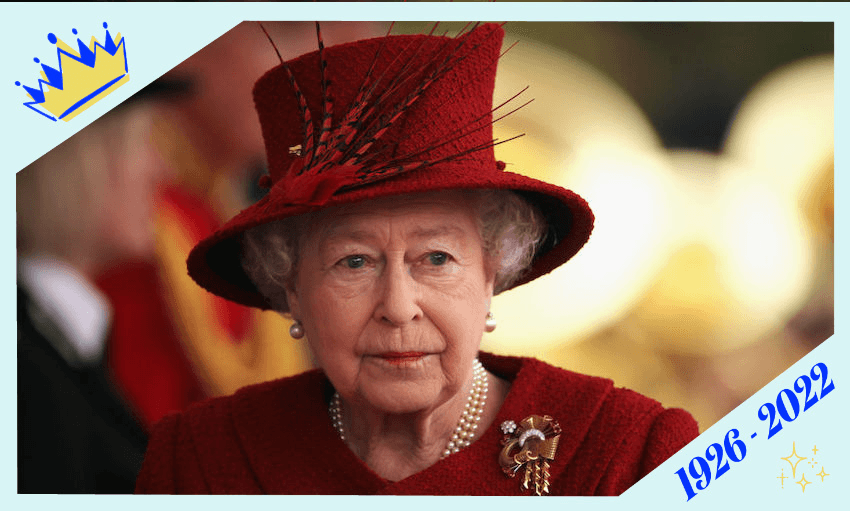He aituā Queen Elizabeth II.
Queen Elizabeth II, the longest reigning British monarch and the second-longest serving sovereign in human history, is dead at 96. Her Majesty lived her life on a timescale that few others could match. When the Queen was 14 the German bombs dropped, devastating London. At 17, the then princess took to wartime service learning to drive and repair military vehicles as the war drew to its final, bloody conclusion. At 26, en route to a royal tour of New Zealand and Australia, word reached Elizabeth II that her father had died. She would ascend to the throne with immediate effect. The touring party turned back, and the princess was proclaimed Queen across her many realms.
No tribute will omit that Queen Elizabeth was a woman of remarkable dignity. One of the great privileges of royalty is vice. But the Queen herself was strangely self-denying, working like the devout Protestant she was. In her three-week tour to New Zealand in 1990 the Queen maintained hundreds of engagements from opening and closing the Commonwealth Games to marking the 150th anniversary of the signing of the Treaty of Waitangi. In an act of royal understatement, she told the country that its founding document had been “imperfectly observed”. In 1995, in an act of regal humility, the Queen herself delivered the Crown’s apology to the people of Waikato-Tainui.
The monarchy is, technically at least, non-political. But Queen Elizabeth was a politician’s politician. In the 1950s she made canny use of the emerging medium of television, broadcasting her coronation to the world. For every previous generation the sovereign was more or less unknowable. A distant, almost enchanted figure. But Queen Elizabeth put a body and a brand to the institution by maintaining a careful relationship with the mass media. She was accessible, but sufficiently mysterious. The sort of person you could have a cup of tea with, so to speak. Yet she also had her hard edges. When Princess Diana tragically died in 1997 the Queen refused to descend from the Scottish north to join the many thousands of mourners in London.
In the end, Her Majesty’s reign was itself tragic, presiding over the long, managed decline of her Empire and her country. When the Queen came to the throne in the midst of Sir Winston Churchill’s second prime ministership Great Britain was still a world power. Only a generation earlier it had commanded a quarter of the Earth’s surface and one fifth of its population. But Elizabeth II surely knew that that brief moment in British history had passed. In 1951 – the year before her father’s death – she had met the most powerful man in the world: the president of the United States, Harry S. Truman, whose access to and authorisation of nuclear weaponry made him and his office more fearsome than the Windsors’ over a Britain that was, even years after the war, under rations.
Perhaps this meant that she had an acute sense of her institution’s vulnerabilities. Historians make much of Elizabeth’s leftist instincts, noting her frosty relationship with the late Margaret Thatcher, the former British prime minister. In that stormy period of the late 1970s and 80s, the two figures were at odds over apartheid South Africa and the miners’ strike. The Queen supported sanctions against South Africa. Mrs. Thatcher opposed them. The Queen privately expressed her sympathy for the miners – an exceptionally rare break from custom – whereas Thatcher was the cause of the miners’ misery.
In one sense, this is evidence of the Queen’s progressive politics. But in another sense it is evidence of her conservatism. Monarchies, no matter their tenants, must resist reform. Thatcher’s entire mission was to uproot the post-war status quo. Reigning over decline, in both Britain and across the Empire, the Queen likely understood the pace of change could soon render her own throne redundant. In the 1990s in New Zealand and Australia, the republican movements were gathering momentum. In New Zealand the Irish Catholic Jim Bolger was prime minister while in Australia the Labor Party republicans Bob Hawke and Paul Keating were in office.
Yet on her visits to both countries in the 1990s she charmed. In 1990, when Bishop Vercoe issued a challenge to the Crown to account for its broken promises at Waitangi, she nudged prime minister Geoffrey Palmer to respond and he took to his feet. In 1995 the Queen won the respect of Waikato-Tainui by travelling to New Zealand to personally sign and assent to their treaty settlement. In context, it was a modest act, but at the time it was read as admirable and necessary. Iwi understood that Her Majesty was the descendant of their guarantor, Queen Victoria.
Queen Elizabeth’s death likely spells the beginning of the end of the monarchy in New Zealand, Australia, and Canada – the last white, English-speaking realms. She was the chieftain of a horrific institution – one that privileges birth right over merit and wealth over charity. But everyone must concede that the Queen herself was a great stateswoman, an ariki of the highest order, and a dignified presence in an increasingly debased society (England). But what comes after? The Queen’s children and grandchildren did not inherit her self-denial. Instead they indulge in all kinds of royal pleasures, from lobbying cabinet ministers to attending American sex parties. This marks the Queen out as much kinder and wiser than her coddled, clueless descendants. It also marks out Her Majesty and her death as perhaps the British Empire’s final close.
Follow our politics podcast Gone By Lunchtime on Apple Podcasts, Spotify or your favourite podcast provider.
